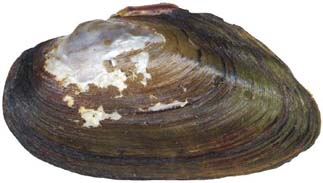Dwarf Wedgemussel
Alasmidonta heterodon
 NH Conservation Status: Endangered (federally endangered)
NH Conservation Status: Endangered (federally endangered)
NH State Rank Status: Critically imperiled (global - critically imperiled)
Distribution: Found only in the Connecticut River watershed (Connecticut River mainstem and the Ashuelot River).
Description: A small wedge-shaped mussel measuring 1-1.5 inches. Color varies from yellowish-brown to blackish-brown. The inner shell (nacre) is bluish-white. The foot is typically pale beige.
Commonly Confused Species: Creeper, brook floater, triangle floater
Habitat: Streams or rivers with a slow to moderate current in a mix of cobble, gravel, and sandy substrates. It has been found in a range of substrates, depths, and stream sizes.
Life History: Host fish are the tessellated darter, Johnny darter, slimy sculpin, mottled sculpin, and Atlantic salmon.
Conservation Threats: Currently the only federally endangered mussel in New England. Threats include pollution, habitat degradation, impoundments created by dams, and reductions in darter and sculpin ranges. The biology of this species likely contributes to its sensitivity. Life span is relatively short compared to other freshwater mussels, around 12 years. They also have relatively low fecundity (i.e., they don’t produce as many successful young) and the dispersal ability of most fish host species is limited. NH has a huge responsibility for this species as the Connecticut River watershed in NH has the 3 largest remaining populations of this species in the world.



